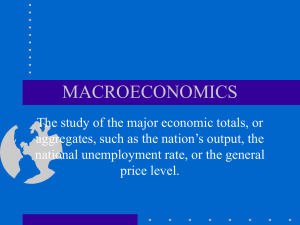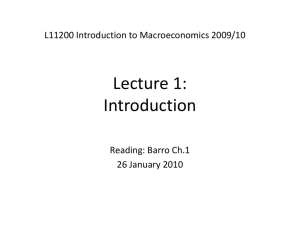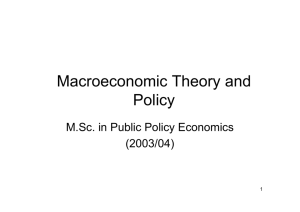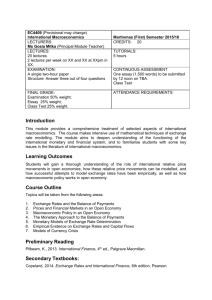Introduction to Macroeconomics Course Handout
advertisement
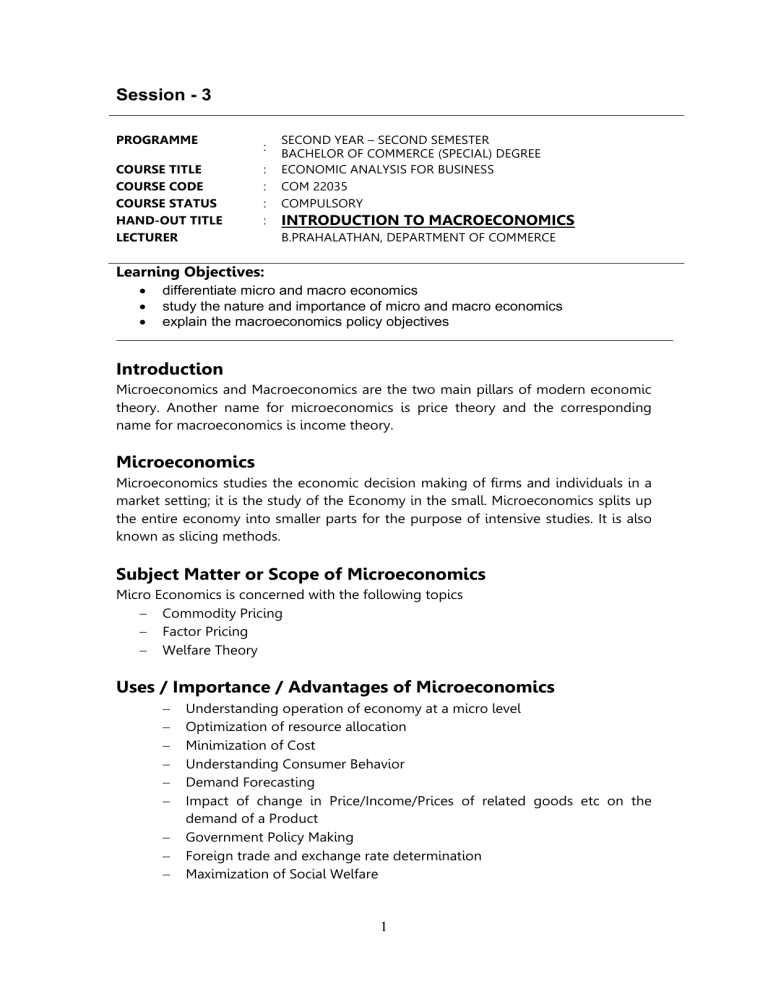
Session - 3 PROGRAMME COURSE TITLE COURSE CODE COURSE STATUS HAND-OUT TITLE LECTURER : : : : : SECOND YEAR – SECOND SEMESTER BACHELOR OF COMMERCE (SPECIAL) DEGREE ECONOMIC ANALYSIS FOR BUSINESS COM 22035 COMPULSORY INTRODUCTION TO MACROECONOMICS B.PRAHALATHAN, DEPARTMENT OF COMMERCE Learning Objectives: differentiate micro and macro economics study the nature and importance of micro and macro economics explain the macroeconomics policy objectives Introduction Microeconomics and Macroeconomics are the two main pillars of modern economic theory. Another name for microeconomics is price theory and the corresponding name for macroeconomics is income theory. Microeconomics Microeconomics studies the economic decision making of firms and individuals in a market setting; it is the study of the Economy in the small. Microeconomics splits up the entire economy into smaller parts for the purpose of intensive studies. It is also known as slicing methods. Subject Matter or Scope of Microeconomics Micro Economics is concerned with the following topics Commodity Pricing Factor Pricing Welfare Theory Uses / Importance / Advantages of Microeconomics Understanding operation of economy at a micro level Optimization of resource allocation Minimization of Cost Understanding Consumer Behavior Demand Forecasting Impact of change in Price/Income/Prices of related goods etc on the demand of a Product Government Policy Making Foreign trade and exchange rate determination Maximization of Social Welfare 1 Macroeconomics Macroeconomics is the study of aggregates covering the entire economy. Thus, macro-economics is related to study of aggregates like total employment, total output, total consumption, total savings, total investment, national income, aggregate demand, aggregate supply, general price level, balance of payments position of an economy etc. Since macro-economic deals with aggregates, it is also known as theory of income and employment or income analysis Nature of Macroeconomics Macro-economic studies the aggregates of the entire economy. The nature of macroeconomic can be understood with the help of the following aspects: Determination of national income and employment Determination of general price level Economic growth and development Distribution of factors of production Macroeconomic Theories Macroeconomic theories use macroeconomic models to explain the behavior of macro economic variables and specify the nature of the relationship between them. Income determination Consumption Investment Employment Price level determination Product and money market equilibrium Exchange rate Balance of payments Macroeconomic Policy Orientation Under Macroeconomic policy orientation Macroeconomic analyses the working and effects of government policies, especially the monetary and fiscal policies, on the economy. Scope and Significance Macroeconomics occupies a significant place in economic analysis and has a lot of theoretical and practical importance. The importance of macro-economic can be understood from the following points: 1. 2. 3. 4. Importance of Aggregate Variables Importance of Macroeconomic Issues Growing Complexity of Economic System Need for Government Intervention with the Market System 2 Macroeconomic Policy Objectives Macroeconomic policies have several objectives. They may be divided into Primary objectives Secondary objectives Primary objectives To achieve full employment To achieve price stability To achieve economic growth Regional development Secondary objectives Full production High standard of living Social welfare Control of monopoly Avoidance of cyclical fluctuations Economic freedom Equilibrium in balance of payments REFERENCES 1. Dwivedi, D.N (2007); MACROECONOMICS: THEORY AND POLICY; S Chand & Co Ltd (December 1, 2007); p23-39. 2. Mariam,M & John kenady; MACROECONOMIC THEORY; PHI Learning Private Ltd; 2011; p3-15. 3. Ahuja,H.L(2007) MACROECONOMICS: THEORY AND POLICY . S Chand & Co Ltd (December 1, 2007) 3
